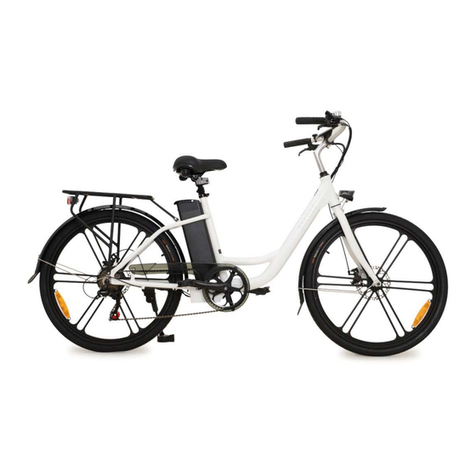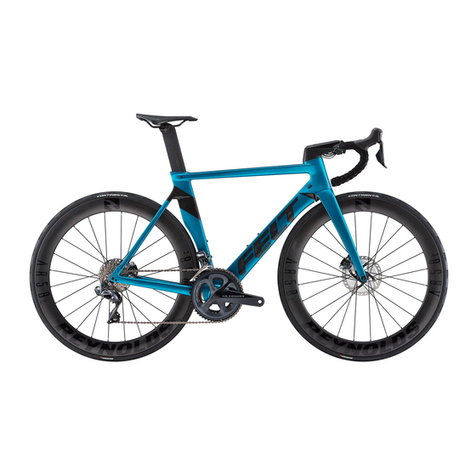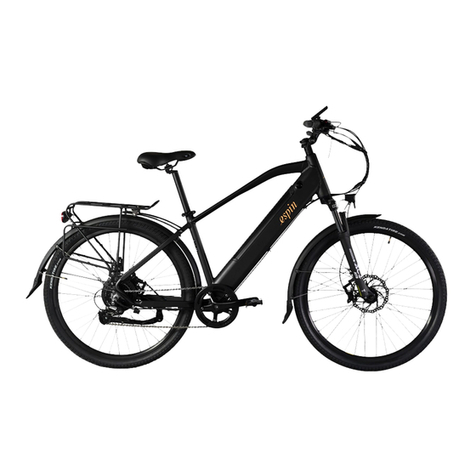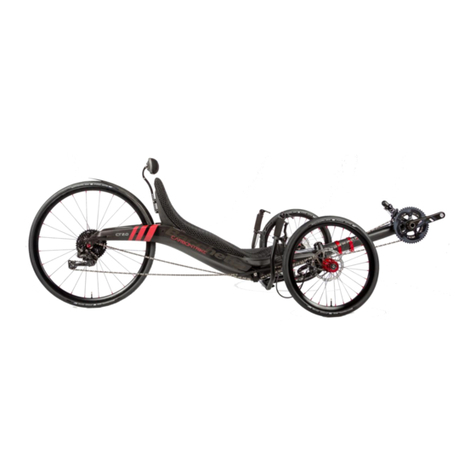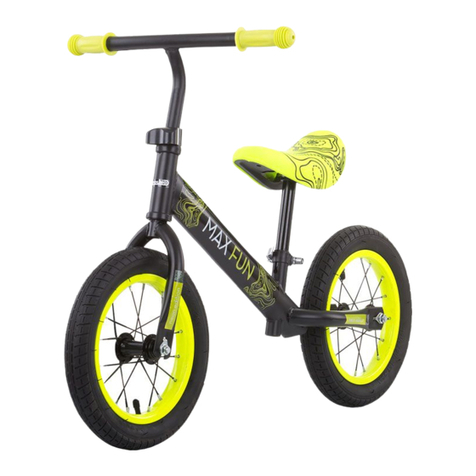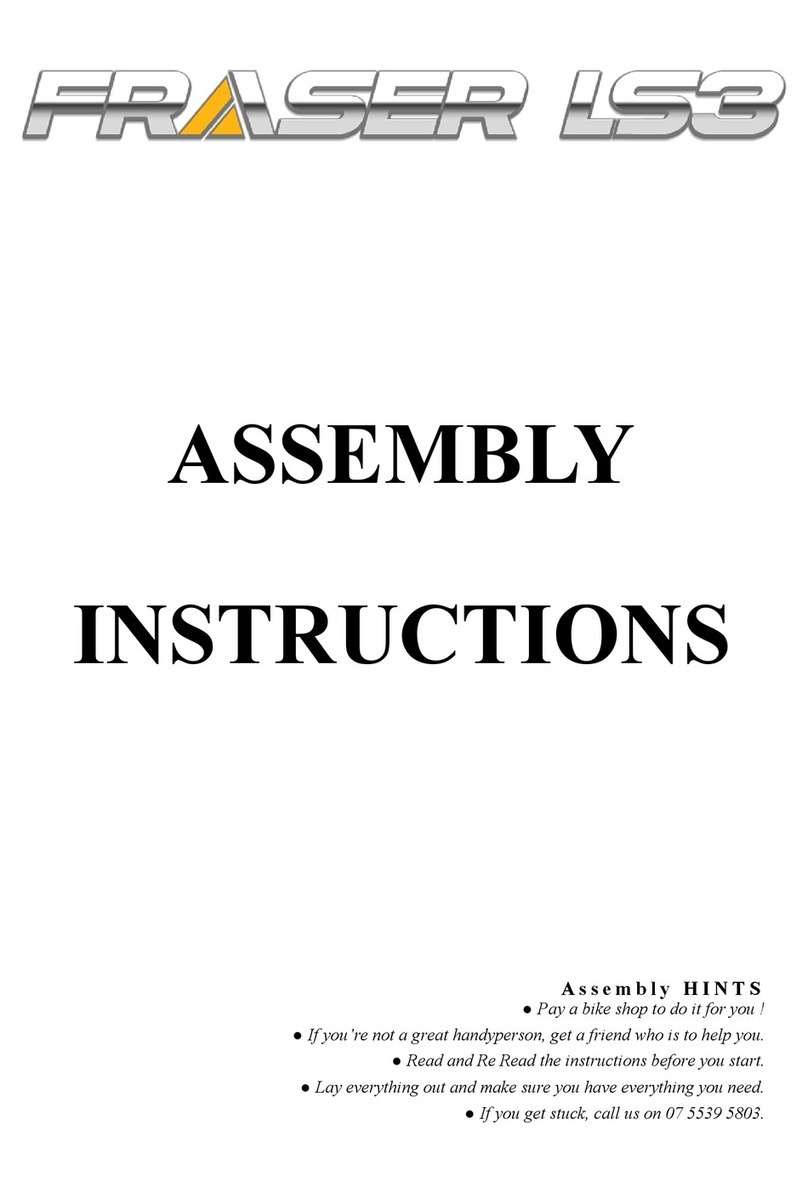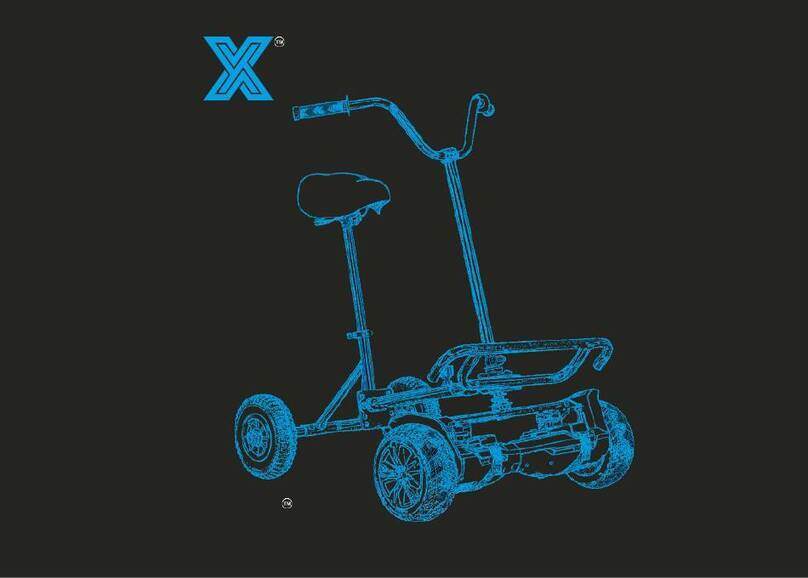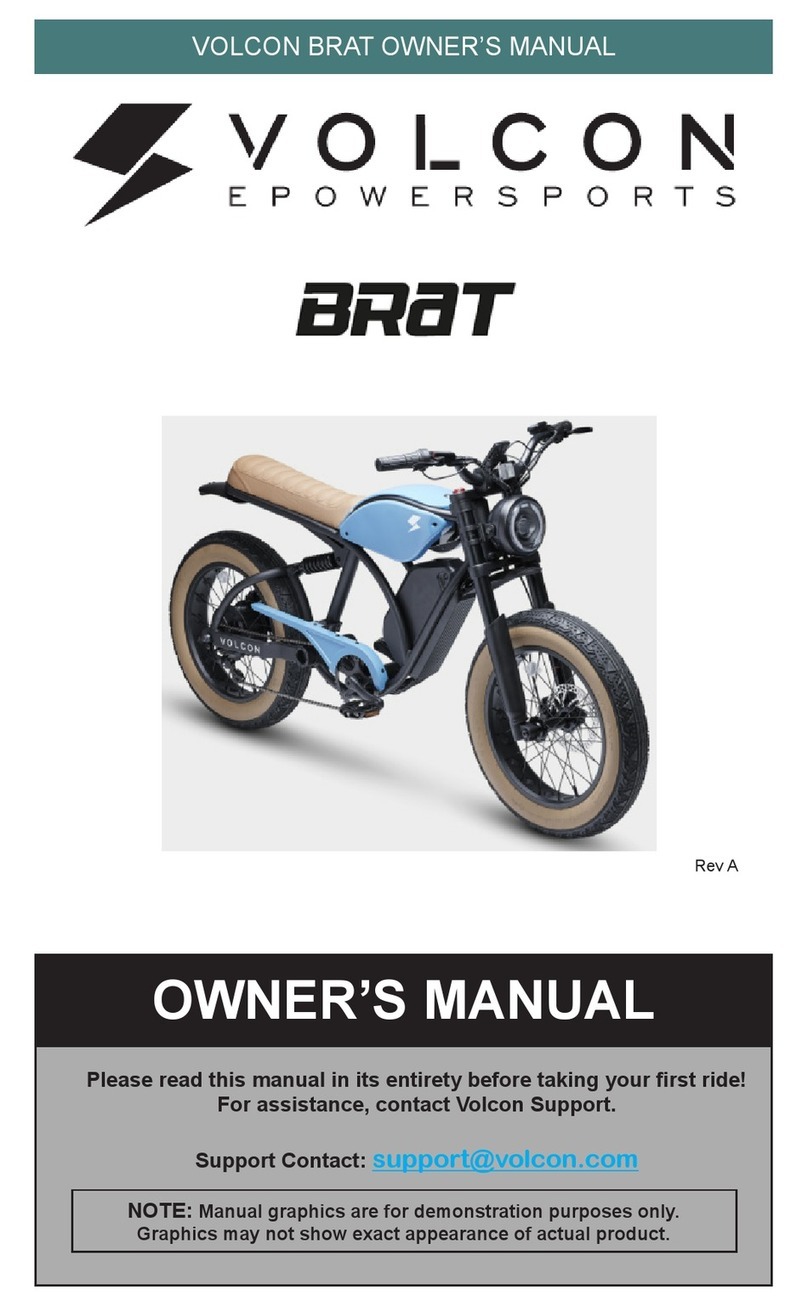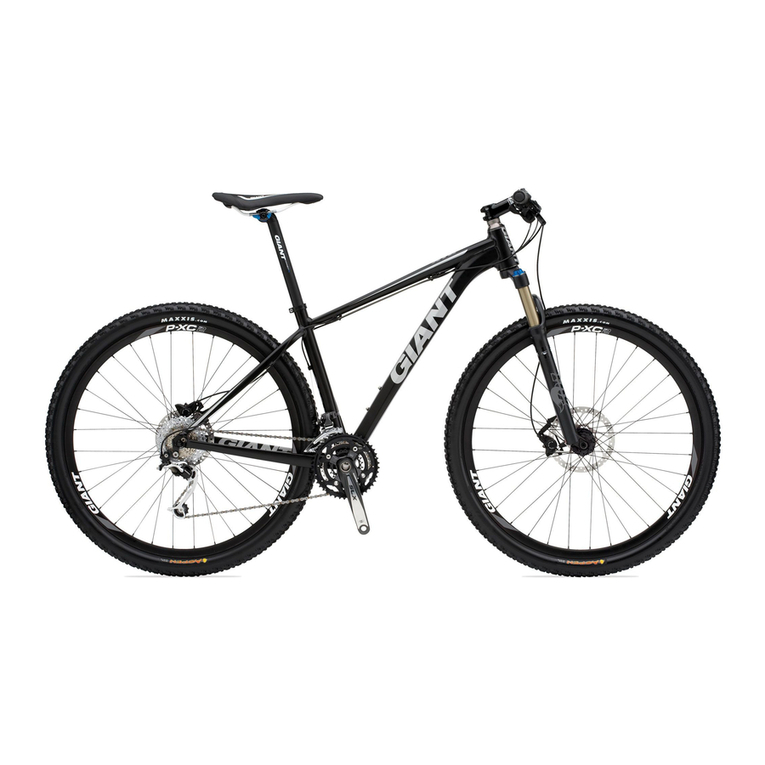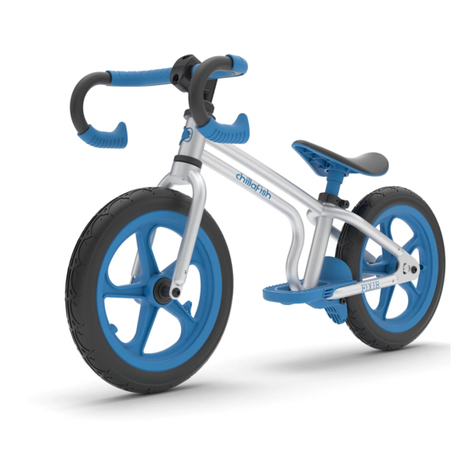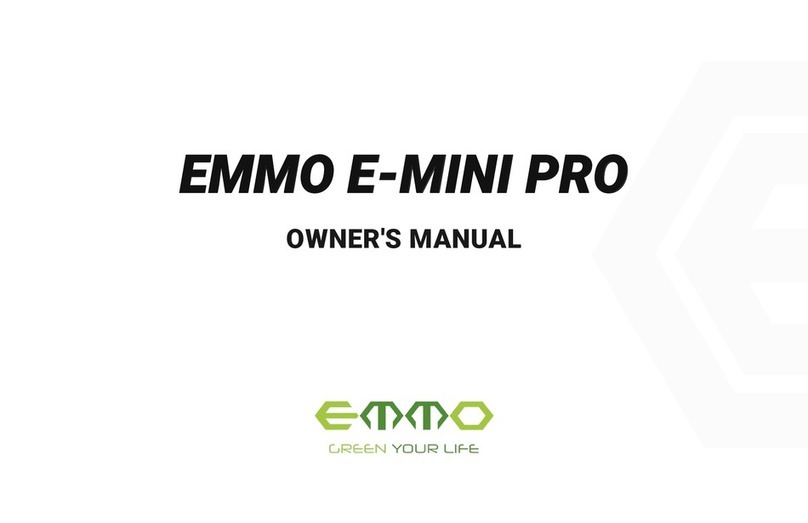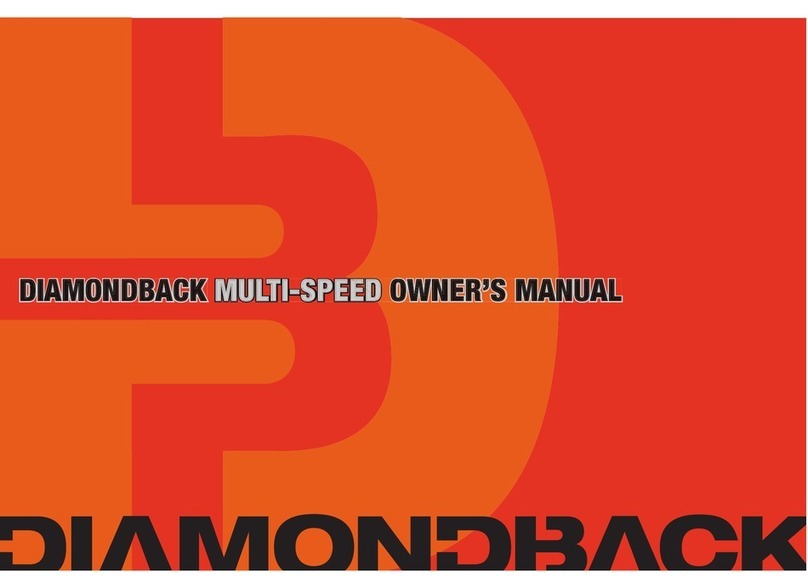Fortis FS27HCMEBKB User manual

27.5” HYBRID COMMUTER
ELECTRIC MOUNTAIN BIKE
(36V 10AH)
FS27HCMEBKB

2
Safety & Warnings
3
Overview
6
Assembly
9
Operation
16
Cleaning & Care
22
Troubleshooting
24
FAQ
25
Notes
27

3
Electric Assisted Bike Regulations
The EN 15194 EU standard or EPAC (Electric Power Assisted Cycle) conforms to the
following characteristics for electric power assisted bikes:
• Motor assistance only starts when the cyclist pedals.
• The assistance cuts out as soon as the cyclist stops pedalling.
• The assistance cuts out as soon as the speed exceeds 25km/h.
Adherence to this standard enables the use of the electric bikes in the same conditions as
any other bicycle, particularly on bicycle paths and bicycle-specific lanes.
Recommendation Before First Ride
• Before first use, please double-check the function of all the parts of your electric bike. If
you have any doubts or if you detect a problem, please contact your authorised dealer
or technical service department.
• If you lend your bicycle to a third party, please give them this instruction manual with
the bicycle and request that they read it before the first ride.
• Respect local and national road traffic regulations.
• For your safety, it is highly recommended that you wear a certified helmet.
• When used during heavy rain, snow, in slippery conditions or in the case of low visibility,
be careful and adjust your speed.
• At night, ride using the lights.
• Trying to repair anything that implies removing technical or electrical components is
strongly advised against. If necessary, please contact your dealer's after-sales service.
• The manufacturer declines any responsibility due to overloading or items that are not
correctly attached to the baggage rack.
• Using high pressured water jets to clean the bike is strongly advised against.
• Check the battery level before use. You must fully charge it before first use.
• To extend battery performance and lifespan, do not half charge and adapt your ride
length to battery level.
• The batteries' life will vary depending on where you ride it (inclines will reduce power
rapidly) and how you ride (assistance mode chosen). The greater the assistance used,
the more you'll use the battery and the shorter it will last. Do not forget that your bike
has gears; remember to use them accordingly relative to riding conditions to extend
battery life. The amount of weight carried also impacts on battery life span. Extreme
low temperatures can also impact battery life span.
SAFETY & WARNINGS

4
• It is recommended that you charge the battery at least every 2 months when the bike is
not used; during winter, for example.
• This bike can be used in the rain; however, it must not be submerged in water or
puddles. The controller, motor and other electrical devices may be short circuited,
causing damage and creating possible dangerous situations.
• Store the battery in a dry place after having completely recharged it. Avoid extreme
temperatures (low and high) as they can damage the battery. Optimal operating range:
-10°C to 35°C.
Warning
• Do not ride after consuming alcohol or drugs (prescribed or not), or while under the
influence of medication which might make you drowsy. This product has the potential
to endanger yourself and others if not operated responsibly.
• Pedal-assisted bicycles are not designed for 2 people. Do not ride carrying passengers
as these bicycles are not designed to carry the additional load of a second rider.
• Do not put batteries in normal waste bins. Dispose of used batteries in a certified
recycling facility.
• Do not over lubricate; if oil contacts the wheel rim, brake pads or brake disks, this will
result in loss of braking performance and an increase in stopping distances. This could
potentially cause loss of control, accidents and injury.
• Electric bikes may usually only be ridden by persons 16 years old and older. Always
consult your local state and city laws to understand the legal age for riding an electric
bike.
• Some bicycle accessories may present a choking hazard and other hazards to small
children. Keep any bike parts, accessories, and tools away from small children.
Safety
It is highly recommended that you do not overload your pedal-assisted bicycle as you could
damage the electrical components or cause malfunctions, like overheating of the battery or
the motor.
• Do not store the battery in excessively hot or cold places.
• Maximum loading weight on the bicycle must not exceed 100kg.
• Regularly check battery brackets and mountings.
• Always wear a helmet when riding your pedal-assisted bicycle.
• If a rack is not already fitted to your bicycle, please do not attempt to fit one yourself.
• Do not carry anything on the rack that may obstruct lights or reflectors.

5
• Never retrofit your bikes with components that are not approved in writing by Kogan.
Serious Injury and even death can result in unauthorised retrofitting and it will void your
warranty.
Cleaning and Maintenance
• Use a damp cloth with neutral detergent to clean the bike frame. Do not use any
detergents or cleaning liquids liable to deteriorate the frame or components.
• Use a dedicated bicycle cleaner or hot soapy water to clean your bike and its
components, such as wheels, hubs, rims, brakes and pedals. Rinse well with clean
water before use.
• Do not use high pressure water jets to clean your bike, especially on the electrical
components (such as the battery), as this may result in short circuiting or system
malfunctions.
• All the components and parts of your bicycle are subject to normal wear and fatigue.
• Keep a close eye on any change in the shape or colour of a component or traces of
oxidation (rust) on your bicycle. If this occurs, do not use the product until the
component has been replaced.
Riding advice
• Never ride in deep water.
• Do not use for jumps or stunts.
• Avoid long distance rides when it is raining.
• Keep both hands on the handlebar.
• Avoid sudden braking.
• Be careful when riding through puddles.
• Thoroughly check the bicycle before each ride.
• Avoid leaving your bicycle in heavy rain or snow. If you do so, wipe dry before use.
• Only use specific bicycle lubricants to lubricate.

6
OVERVIEW

7
1
Stem
18
Battery button
2
Display
19
Pedal
3
Handlebar & grips
20
Crank set
4
Bell
21
Chain
5
Shifter
22
Motor
6
Brake lever
23
Rear derailleur
7
Head light
24
Wheel reflector
8
Front fork
25
Freewheel
9
Rim
26
Rear brake
10
Spoke
27
Rear disc rotor
11
Wheel reflector
28
Seat clamp
12
Tire & tube
29
Seat post
13
Hub & quick release
30
Rear reflector
14
Front disc rotor
31
Saddle
15
Front brake
32
Frame
16
Battery
33
Bottom bracket & speed sensor
17
Controller
34
Charging port
Notes:
Kickstand, water bottle & pump are not shown but also included with this bike.

8
Tools supplied
3mm Allen Key
4mm Allen Key
5mm Allen Key
6mm Allen Key
& Phillips Head
Multifunction
Wrench
• Keypad
• Display
adjustment
• Kickstand
length
• Handlebar
• Water bottle
screw
adjustment
• Brake
• Stem
• Brake lever
• Kickstand nut
• Front light
adjustment
• Saddle
• Bell
• Reflector
adjustment
• Pedal
adjustment
Recommended Fastener Torque
Part
Fastener size
Torque
Stem locking screw lock
M8
18-25 N.m.
Saddle lock
M8
20-25 N.m.
Front wheel nut
M10
30-35N.m.
Rear wheel nut
M10
35-40N.m.

9
Step 1: Getting Started
1. Remove the bike and all accessories from the packaging.
2. DO NOT dispose of the original packaging until assembly is complete.
3. Check packaging thoroughly to ensure all components removed.
4. Before continuing ensure the following pieces are present:
o Electric bike
o Front wheel
o Small box (user guide, tools, pedals, reflectors, quick release & warranty card)
o Charger
5. Remove any cable ties, plastic covers and protective materials from the bike
components before commencing assembly.
ASSEMBLY
WARNING: Before assembling your new e-bike, charge the battery for 4-6 hours
until fully charged.

10
Step 2: Install the front wheel
1. Ensure the fork is facing forward. Rotate it to ensure it moves freely without binding
any of the cables (Figure 1).
2. Place the wheel in a central position between the frame dropouts and the fork.
3. Install the quick release and ensure each side has a spring (the small opening in
the springs should be facing inwards). Note: Ensure the quick release lever is on
the same side as the brake disc (Figure 2).
4. Tighten the adjusting nut.
5. Close the quick-release lever. To prevent it coming loose, it is necessary to tighten
the adjusting nut, so that the quick-release lever requires a moderate amount of
force to close but not to a point where it is difficult to close it.
WARNING: Do not touch the brake rotor. The sharp edges can cause serious injury.
Touching the brake rotor or brake pads with bare skin can transfer natural oils to either
component, which may decrease braking performance. It is recommended to wear
clean gloves during assembly.
Adjusting nut
Lever
Small opening
Figure 1
Figure 2

11
6. To increase the closing force: rotate the adjusting nut clockwise.
7. To decrease the closing force: rotate the adjusting nut counter-clockwise.
Closed position
Force adjustment
Open position
Note: Ensure the brake disk rotor is evenly spaced between the brake pads.
WARNING: An improperly secured front or rear wheel can cause loss of control,
accidents, serious injury or death. Check that both wheels are properly secured during
assembly and before each ride.

12
Step 3: Install the handlebar
1. Loosen the steerer clamp bolts and stem binder bolt, rotate the stem tube 180° to
make it face forward. Check and align the stem with the front wheel, then tighten
the stem binder bolt (Figure 3).
2. Remove the faceplate by releasing the 4 four faceplate bolts.
3. Install the handlebar o the brake levers face forwards and the shifter is on the
rider’s right side. Trace the brake housing from the left brake lever to the brake
calliper and check that the cables are not twisted.
4. Place the handlebar in the desired riding position. Reinstall the faceplate and 4
faceplate bolts. Following an “X” pattern (Figure 4) tighten the 4 faceplate bolts
evenly to ensure the force of the four corners is balanced. Using the centre mark,
check that the handlebars are symmetrical and in the correct position. Repeat
until the handlebar is secure. Note: Ensure the gap “A” between the faceplate and
stem tube is even.
5. Ensure the stem binder bolt, steerer clamp bolt and faceplate bolts are all secure.
Stem binder bolt
Steerer clamp bolts
Handlebar
Handlebar faceplate
Faceplate bolts
A
A
Stem structure
Tighten faceplate bolts in
an ‘X’ pattern
Handlebar faceplate
Figure 3
Figure 4
Stem tube
Center mark

13
Step 4: Install the pedals
1. The left and right pedals are clearly marked with an “L” and an “R”.
2. Attach pedal to the crank by gently threading them in by hand.
o Left pedal is installed in a counter-clockwise direction.
o Right pedal is installed in a clockwise direction.
3. Taking care not to cross thread the pedals, use the multi-function wrench to
torque each pedal to 45 N.m.
o Left pedal is tightened in a counter-clockwise direction.
o Right pedal is tightened in a clockwise direction.
Left pedal
Right pedal
Thread by hand
Tighten with multi-function wrench
WARNING: Ensure the pedals are installed correctly. The left and right pedals have
opposite threads. Cross threading or installing the wrong pedal will cause irreparable
damage to the crank.

14
Step 5: Install the seat post and front & rear reflectors
1. Loosen the screws on the rear reflector bracket then attach the rear reflector to the
seat post.
2. The rear reflector needs to be aligned straight anda facing towards the rear of the
bicycle. Ensure there is at least 7.6cm of clearance between the top of the seat
and the top of the rear reflector.
3. Open the quick release seat clamp and insert the seat post into the frame. Set the
desired height of the seat enusring the minimum insertion mark (Figure 5) on the
seat post is below the clamp and not visible.
4. Use your palm to close the quick release clamp (Figure 6). Ensure the seat is tight
enough so that it cannot twist.
5. To adjust the height further, open the seat clamp and slide the seat up or down.
Seat post out too far
The minimum insertion point on the
seat post must be inserted into the
seat tube.
WARNING: Be sure the minimum insertion marks do not go past the top of the seat
clamp and are not visible.
Figure 5
Figure 6

15
Step 6: Install the front reflector
1. Remove the screw on the front reflector bracket.
2. Attach the reflector on the left side of the handlebar and secure it in place using
the screw.
Step 7: Adjusting the headlight
1. To adjust the headlight angle, use the 5mm Allen Key to loosen the adjustment
bolt (Figure 7), adjust the headlight to the desired angle.
2. Tighten the adjustment bolt to secure light in place.
Note: Before starting up the electrical system, ensure the battery is fully charged and
the battery switch is in the on position.
Figure 7

16
Starting the System
• Press and hold Bfor 2 seconds to turn the bike on.
• Short pressing Bwill turn the bike off.
• With the bike turned on, press and hold Afor 2 seconds to turn the headlight on
• Short pressing Awill turn the headlight off.
Control Pad
A: More assistance
B: Power/Mode
C: Less assistance
Instrument Display
OPERATION
Speed mode
Speed display
Battery level
Highlight
indicator
Walk mode
Pedal assistance
Current
assist level
Motor failure
Controller failure
Undervoltage
Assist indicator
Multifunction
indicator
A
B
C

17
Instrument Display Functions
Assist (PAS) level:
• Press Ato increase the level of assistance by 1.
• Press Cto decrease the level of assistance by 1.
• The highest level is 5.
• The default setting for assistance is 0. In this setting there is no assitance from the
motor.
Walk mode
• When the vehicle is stationary, press and hold Cfor 2 seconds to enter walk mode
• Releasing the button will exit walk mode.
• The maximum speed in walk mode is less than 6km/h.
Multifunctional indicator
When the display is on, short press the mode button Bto cycle through the different
functions (TRIP/ODO/TIME/VOL/CUR/ERROR CODE).
Mode
Function
Display
TRIP
Displays current trip distance
ODO
Displays the bike’s odometer
TIME
Displays the current trip time
VOL
Displays battery voltage
CUR
Displays battery current
Note:Use walk mode only while dismounted from the bike. Always keep both hands
on the handlebars so that you can quickly stop the bike if necessary.
Note: Error codes will also be displayed in this area if there has been a malfunction.
Refer to the troubleshooting section for more information.

18
Speed mode
When the display is on, press and A+B buttons together to switch between the the speed
mode that is currently being displayed.
• CUR:Current speed
• MAX: Maximum speed
• AVG: Average speed
Battery level indicator
100%
80%
50%
25%
15%
0%
WARNING: If there is only one bar left on the display, users should charge
the battery as soon as possible. At lower battery levels, the bike may limit
power output to maximise remaining power. This will help reduce wear on the
battery. When the battery is fully depleted, the last bar will begin to flash,
alerting the user that they’re about to lose all electrical power. If the power is
off or the battery is depleted, you can still propel the bike by pedalling.

19
Settings
Press and hold the A + C buttons together to enter the settings menu. In this menu you can
adjust the following parameters:
• Backlight brightness: 1-3 levels
• Milage unit (KM or MILE),
• Odometer reset.
Short press the Bbutton to switch between the different parameter menus.
Backlight brightness
While in the settings menu, pressing A or B will adjust level of the backlight:
1: Darkest
2: Default
3: Brightest
Press and hold the A + C buttons together to save the value and exit the settings interface.
Mileage unit
While in the settings menu, press the Abutton to set the unit to KM (default). Press the C
button to set the unit to Miles.
Press and hold the A + C buttons together to save the value and exit the settings interface.
Reset Odometer
While in the settings menu, press and hold the Abutton for 5 seconds to reset the
odometer.
Press and hold the A + C buttons together to exit the settings interface.
Note: While inside the settings menu, if there is not user input for 10 seconds the value
will save and exit automatically.

20
Battery power switch
The battery power switch is located at the bottom of the bike frame. Place the the switch in
the "—" position to turn the power on. Place the switch in the "O" position to turn the
power off.
Charging the battery
To charge the battery, connect the battery charger to the charging port on the bike.
Connect the other end of charger to a power outlet and turn it on. When the battery is
charging, the LED light will be RED. Once the battery is fully charged the light will turn
GREEN.
Warning:
• It is highly recommended to charge your battery in a room which has a smoke detector.
Do not charge the battery in your bedroom.
• Always charge the battery in a well-ventilated area. Keep away from flames and
sources of ignition.
Power switch
Charging port
To power outlet
To charging port
Table of contents
Other Fortis Bicycle manuals
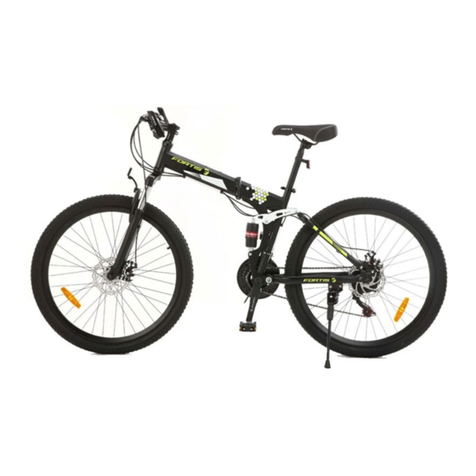
Fortis
Fortis FSMFEXR200A User manual
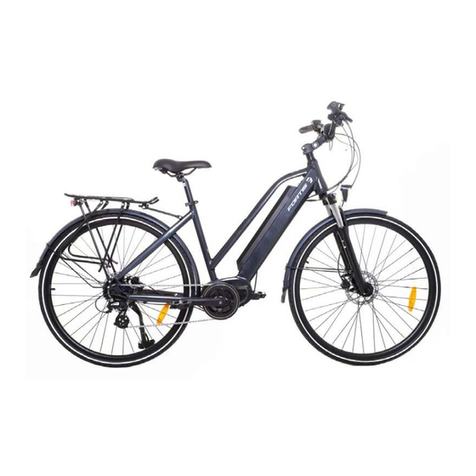
Fortis
Fortis 700C BAFANG User manual
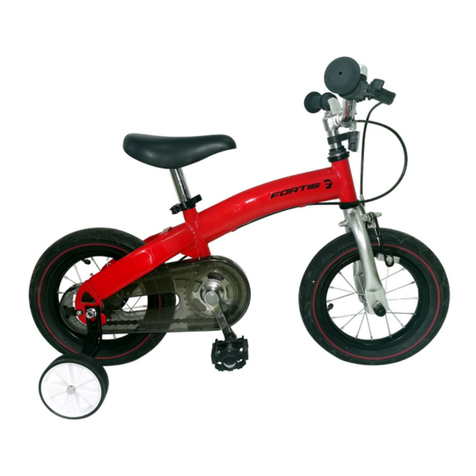
Fortis
Fortis FS2N1KB12WA User manual

Fortis
Fortis 700C URBAN MASTER ROAD BIKE User manual
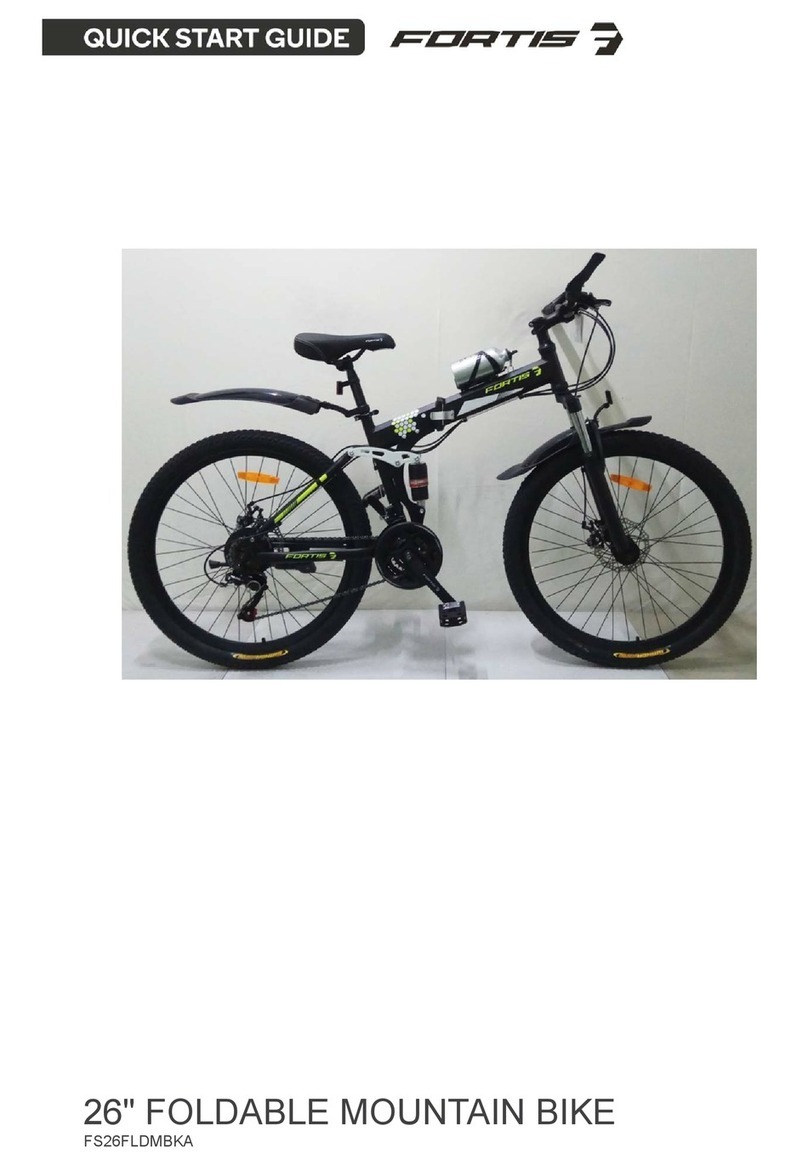
Fortis
Fortis FS26FLDMBKA User manual
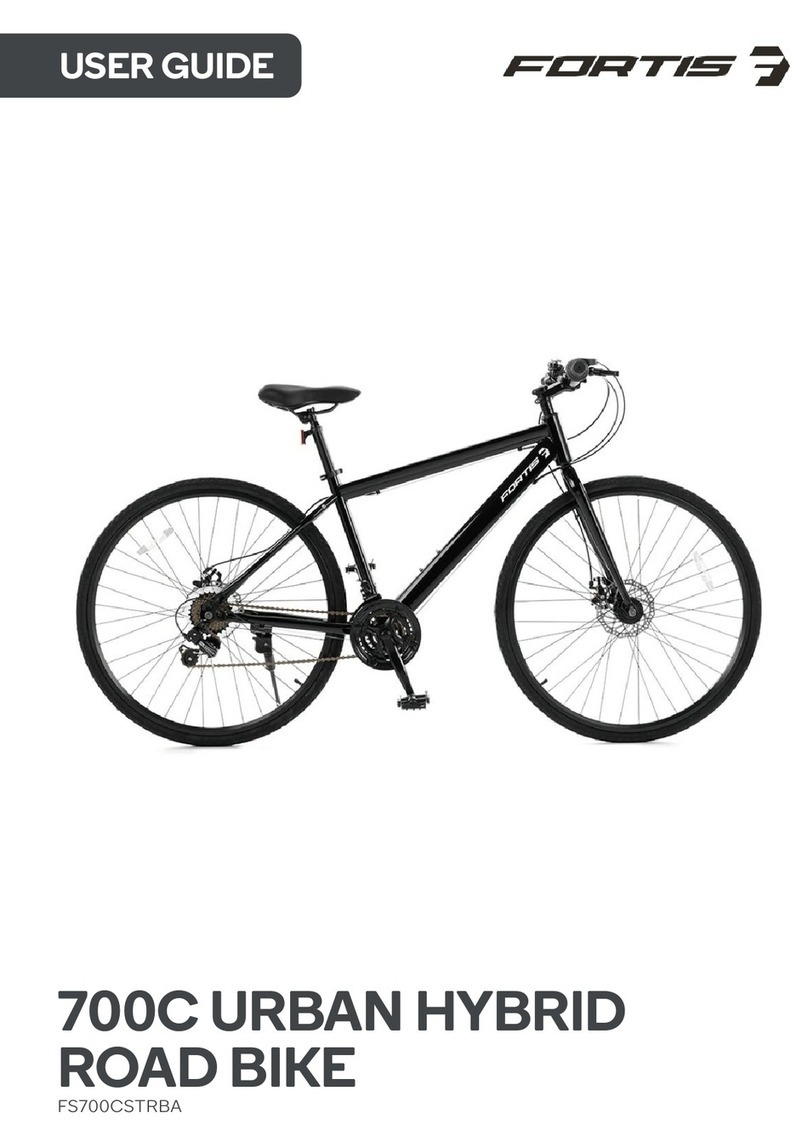
Fortis
Fortis 700C URBAN HYBRID User manual
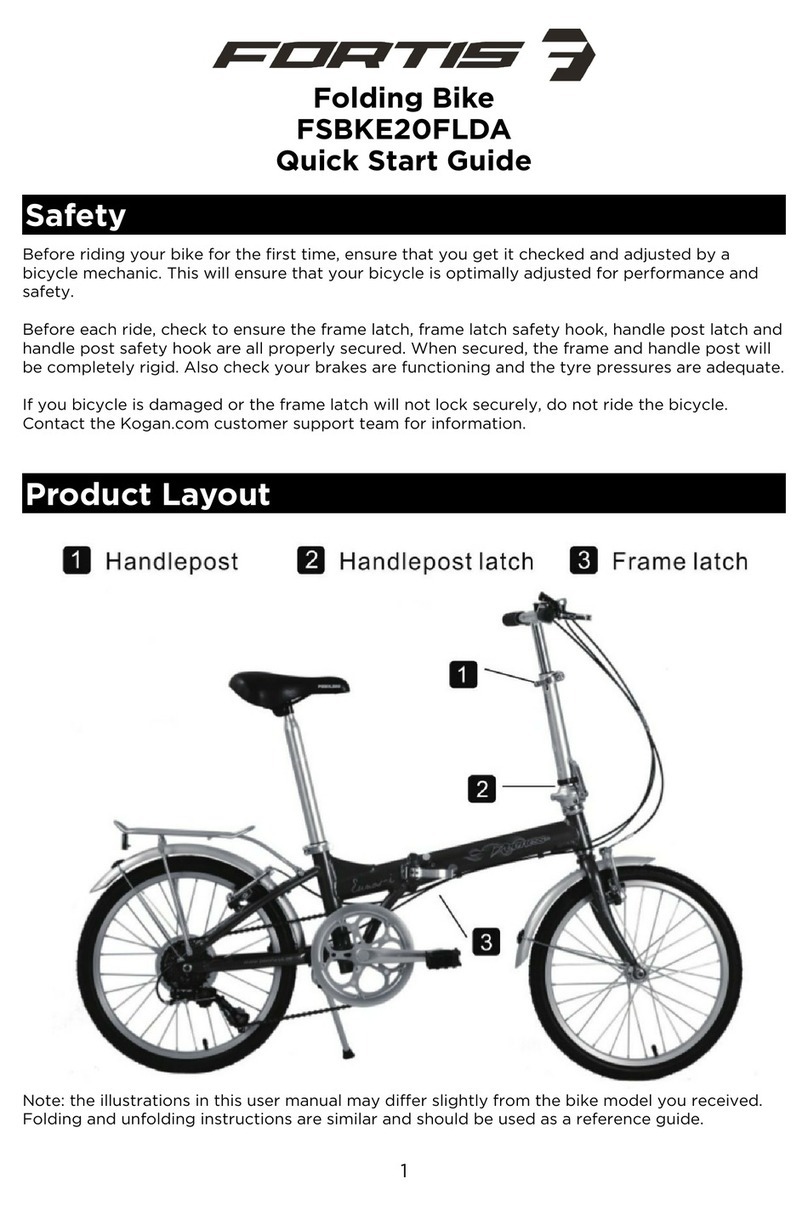
Fortis
Fortis FSBKE20FLDA User manual

Fortis
Fortis 700C CITY BREEZE LADIES BIKE User manual
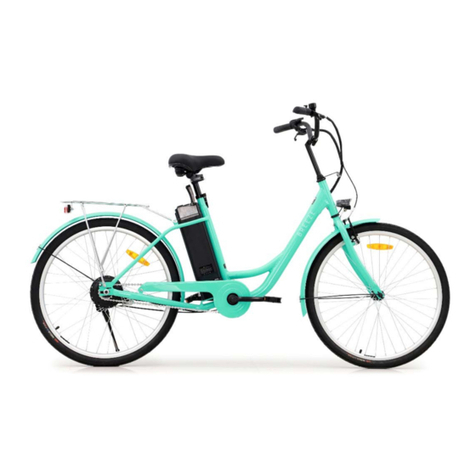
Fortis
Fortis FS26LDEBKSA User manual
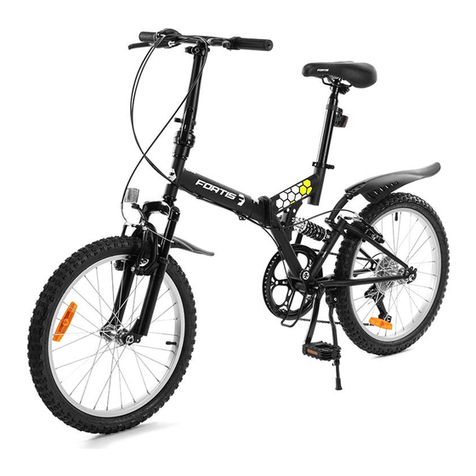
Fortis
Fortis FS20FDMTBBA User manual
